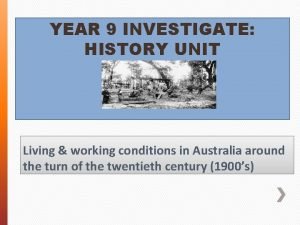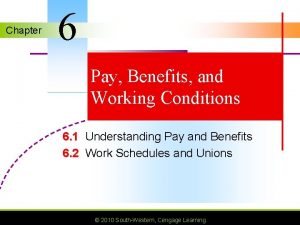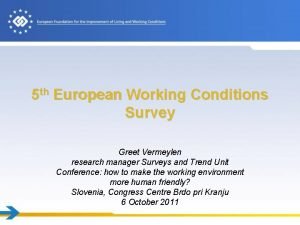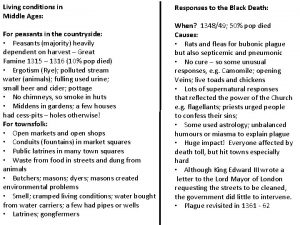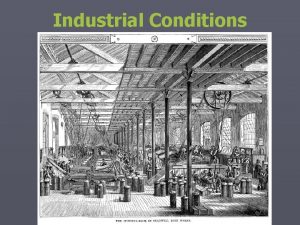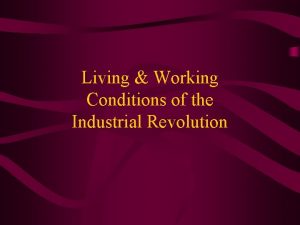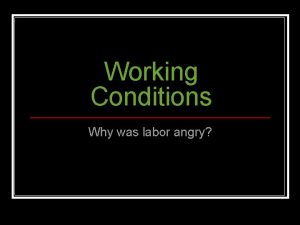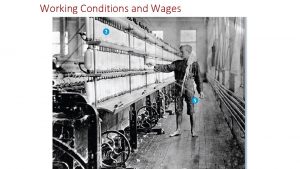Working Living Conditions of the Industrial Revolution A













- Slides: 13

Working & Living Conditions of the Industrial Revolution A. The Factories B. Working Conditions C. The Cities

Capitalism • Capitalism refers to the private ownership of the means of production • Capitalists had the money to buy the necessary materials, machines, and labor to produce goods • The theory of laissez-faire allowed the capitalist to run their businesses without government regulation

• New Class System • The Middle Class will become a very large and important part of society • The Middle Class were the owners of the factories

A. The Factories • Factories housed the machines that produced the goods.

• Assembly Lines: method used in the factories to produce goods • Instead of one person completing all tasks to produce a good, the process was broken into small parts • Each person was assigned a skilled task • This was called specialization or the division of labor

• The assembly line was an improvement over the domestic system (making goods by hand at home) • Economic impact of the factories (how it changes the economy): – Output of goods increased – more goods produced daily • Ex: instead of 1 doll per day by hand, 500 per day – Quality of manufactured goods increased - Goods were better than before • Ex: the hair of the doll would now stay on instead of falling off – Cost of goods decreased – more was being produced, so the price of the good went down • Ex: Dolls made by hand before the IR cost $500, now $10

B. Working Conditions in Factories • Conditions in the factories were harsh (horrible) • Factories were: – poorly ventilated (the air was stale & dirty) – poorly lit – the machines were very dangerous

• Jobs in the factories paid very little • Men were required to work at least 14 hours a day • Because of the low wages paid, families couldn’t be supported by the man alone • Women had to go to work in the factories • Eventually the children will also go to work in the factories

• • Injuries occurred often If you were hurt, you lost your job There was no compensation or medical insurance The managers or overseers were abusive to all of the workers, but especially the children

• To push for better working conditions, workers began to form labor unions • The Unions were not seen favorably by the factory owners

C. The Cities • Urbanization: growth of cities as people move into them • This will occur as people search for jobs in the factories since they can no longer farm

• The living conditions in cities were horrible for the WORKERS – Lack of sanitary codes • No trash pick up – all trash went into the streets and STAYED THERE • Same for human waste – Lack of adequate housing • Not enough housing so multiple families would share a 1 room apartment – Education • No Schools – Pollution • Factories polluted the air and rivers – Crowded – No police protection

• Diseases were common in cities • Lack of sewage systems led to regular epidemics (outbreaks) of diseases such as Cholera
 Working conditions during the industrial revolution
Working conditions during the industrial revolution Living and working conditions in australia 1900
Living and working conditions in australia 1900 Job description computer programmer
Job description computer programmer Kondisi kerja dan psikologi kerekayasaan
Kondisi kerja dan psikologi kerekayasaan Fair working conditions
Fair working conditions European working conditions survey 2020
European working conditions survey 2020 Chapter 6 pay benefits and working conditions
Chapter 6 pay benefits and working conditions European working conditions survey
European working conditions survey Living conditions in the middle ages
Living conditions in the middle ages Hard work vs smart work
Hard work vs smart work Hot working of metal is
Hot working of metal is Hot working and cold working difference
Hot working and cold working difference Differentiate between hot working and cold working
Differentiate between hot working and cold working Pengerjaan panas
Pengerjaan panas

